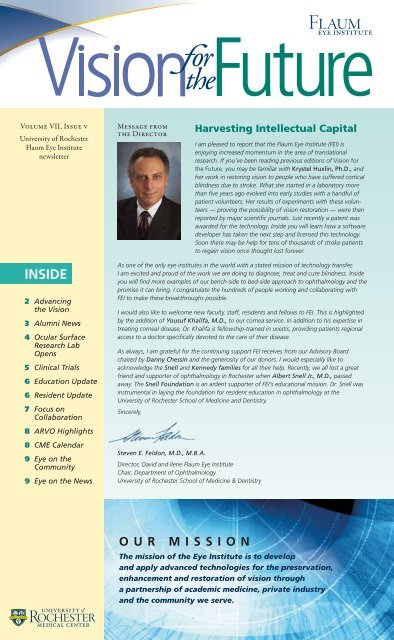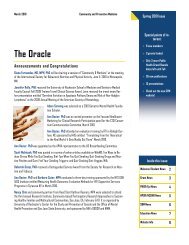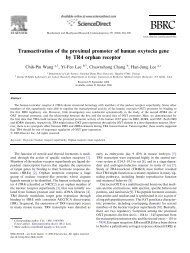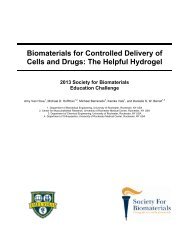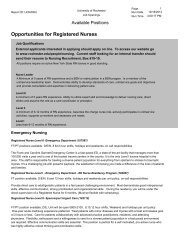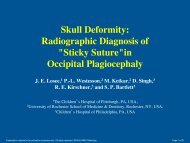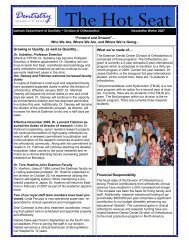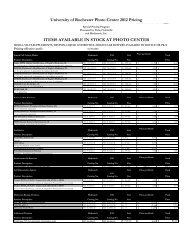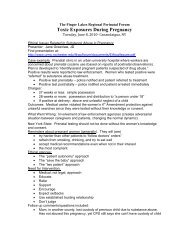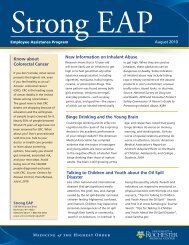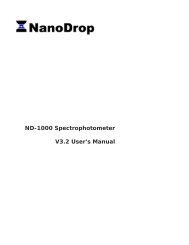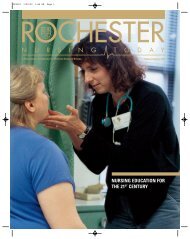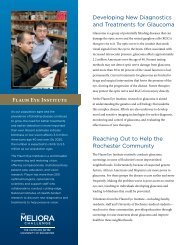INSIDE - University of Rochester Medical Center
INSIDE - University of Rochester Medical Center
INSIDE - University of Rochester Medical Center
Create successful ePaper yourself
Turn your PDF publications into a flip-book with our unique Google optimized e-Paper software.
Volume VII, Issue v<br />
<strong>University</strong> <strong>of</strong> <strong>Rochester</strong><br />
Flaum Eye Institute<br />
newsletter<br />
<strong>INSIDE</strong><br />
2 Advancing<br />
the Vision<br />
3 Alumni News<br />
4 Ocular Surface<br />
Research Lab<br />
Opens<br />
5 Clinical Trials<br />
6 Education Update<br />
6 Resident Update<br />
7 Focus on<br />
Collaboration<br />
8 ARVO Highlights<br />
8 CME Calendar<br />
9 Eye on the<br />
Community<br />
9 Eye on the News<br />
Message from<br />
the Director<br />
O U R M I S S I O N<br />
harvesting intellectual Capital<br />
I am pleased to report that the Flaum Eye Institute (FEI) is<br />
enjoying increased momentum in the area <strong>of</strong> translational<br />
research. If you’ve been reading previous editions <strong>of</strong> Vision for<br />
the Future, you may be familiar with Krystel Huxlin, Ph.D., and<br />
her work in restoring vision to people who have suffered cortical<br />
blindness due to stroke. What she started in a laboratory more<br />
than five years ago evolved into early studies with a handful <strong>of</strong><br />
patient volunteers. Her results <strong>of</strong> experiments with these volunteers<br />
— proving the possibility <strong>of</strong> vision restoration — were then<br />
reported by major scientific journals. Just recently a patent was<br />
awarded for the technology. Inside you will learn how a s<strong>of</strong>tware<br />
developer has taken the next step and licensed this technology.<br />
Soon there may be help for tens <strong>of</strong> thousands <strong>of</strong> stroke patients<br />
to regain vision once thought lost forever.<br />
As one <strong>of</strong> the only eye institutes in the world with a stated mission <strong>of</strong> technology transfer,<br />
I am excited and proud <strong>of</strong> the work we are doing to diagnose, treat and cure blindness. Inside<br />
you will find more examples <strong>of</strong> our bench-side to bed-side approach to ophthalmology and the<br />
promise it can bring. I congratulate the hundreds <strong>of</strong> people working and collaborating with<br />
FEI to make these breakthroughs possible.<br />
I would also like to welcome new faculty, staff, residents and fellows to FEI. This is highlighted<br />
by the addition <strong>of</strong> Yousuf Khalifa, M.D., to our cornea service. In addition to his expertise in<br />
treating corneal disease, Dr. Khalifa is fellowship-trained in uveitis, providing patients regional<br />
access to a doctor specifically devoted to the care <strong>of</strong> their disease.<br />
As always, I am grateful for the continuing support FEI receives from our Advisory Board<br />
chaired by Danny Chessin and the generosity <strong>of</strong> our donors. I would especially like to<br />
acknowledge the Snell and Kennedy families for all their help. Recently, we all lost a great<br />
friend and supporter <strong>of</strong> ophthalmology in <strong>Rochester</strong> when Albert Snell Jr., M.D., passed<br />
away. The Snell Foundation is an ardent supporter <strong>of</strong> FEI’s educational mission. Dr. Snell was<br />
instrumental in laying the foundation for resident education in ophthalmology at the<br />
<strong>University</strong> <strong>of</strong> <strong>Rochester</strong> School <strong>of</strong> Medicine and Dentistry.<br />
Sincerely,<br />
Steven E. Feldon, M.D., M.B.A.<br />
Director, David and Ilene Flaum Eye Institute<br />
Chair, Department <strong>of</strong> Ophthalmology<br />
<strong>University</strong> <strong>of</strong> <strong>Rochester</strong> School <strong>of</strong> Medicine & Dentistry<br />
The mission <strong>of</strong> the Eye Institute is to develop<br />
and apply advanced technologies for the preservation,<br />
enhancement and restoration <strong>of</strong> vision through<br />
a partnership <strong>of</strong> academic medicine, private industry<br />
and the community we serve.
2<br />
A D V A N C I N G t h E V I S I O N<br />
The David and Ilene Flaum Eye Institute is most grateful to its donors for their generous gifts and ongoing support.<br />
We are especially appreciative to the friends, patients, alumni and faculty who contributed to our Eye Institute Annual<br />
Fund. The Annual Fund is an essential source <strong>of</strong> funding that will help continue our groundbreaking work in vision care<br />
and research.<br />
The following donors have contributed in various ways to FEI between Nov. 1, 2009, and June 1, 2010. Gifts can be designated<br />
to the Annual Fund and mailed to: Desirae Jourdan, Director <strong>of</strong> Development, FEI, 210 Crittenden Blvd., Box 659,<br />
<strong>Rochester</strong>, NY 14642. Or make a gift online by going to eyeinstitute.urmc.edu and clicking on “Support the Eye Institute.”<br />
Norman A. Aborjaily<br />
Wendy Ahlheim<br />
Alcon Laboratories<br />
Sharon Allen ’76 (MD) and<br />
James S. Allen ’77 (Res)<br />
Ann E. Anderson<br />
Anonymous Check Donors<br />
Barbara Asselin ’81 (MD) and<br />
Dennis A. Asselin ’81 (MD),<br />
’87 (Res)<br />
Catherine and James Aquavella<br />
Charlotte H. Baker and<br />
Robert B. Baker<br />
Bausch + Lomb, Inc.<br />
Peter Battisti<br />
Henry Joseph Beetz ’59 (MS)<br />
Joan C. Binnie<br />
Jay B. Birnbaum<br />
Rosemary Boesel<br />
Elizabeth A. Boguslawski<br />
Philip P. Bonanni ’64 (MD),<br />
’71 (Res)<br />
Doris Braine ’73 (MA)<br />
Marlys A. Braunlich and<br />
Harry R. Braunlich<br />
Louis V. Brescia<br />
Irene Brixner and Jerome F. Brixner<br />
Barbara A. Brown<br />
Karen Susan Brown ’77 (BS)<br />
Randall L. Brown ’82 (Res)<br />
Fina Fran Brunetti<br />
Kenneth A. Bumpus<br />
Burroughs Wellcome Fund<br />
Peter Capponi<br />
Rita P. Carbone<br />
Barbara L. Carpenter<br />
Rita M. Carrier<br />
Betsy Carver and John P. Carver<br />
Matilda Chan ’06 (Res)<br />
Percival H. Y. Chee ’62 (MD)<br />
Sally Chernoy and Eugene Chernoy<br />
Rina F. Chessin and Daniel J. Chessin<br />
Steven See Tau Ching ’74 (MD), ’81<br />
(Res) and Mary Dante Ching<br />
Maureen W. Chisholm<br />
Mary E. Clark<br />
Martha B. Cleland<br />
Barbara Cohen and Irving J. Cohen<br />
Doris E. Cohen ’54 (BA) and<br />
Jules Cohen ’53 (BA), ’57 (MD)<br />
Ronald J. Cole ’62 (MD)<br />
Robert M. Conway<br />
Ruth L. Cooper<br />
David Arthur Costello<br />
Virginia J. Covert and Brian E. Covert<br />
Shelly L. Coville and David Coville<br />
Stella Cushman<br />
John D’Amico Jr.,<br />
Deborah A. Dassero and<br />
William F. Dassero<br />
Carol Datthyn<br />
Jody Davis<br />
John H. Dengler<br />
Delta Gamma <strong>of</strong> <strong>Rochester</strong><br />
V. Sumati Devadutt ’64 (BA),<br />
’66 (MA)<br />
Catherine A. Dobbertin and<br />
Clemens A. Dobbertin<br />
David Allen DiLoreto Jr., ’95 (MS),<br />
’95 (PhD), ’97 (MD) and<br />
Zoë Williams ’08 (Res)<br />
Ann E. Dwyer DVM<br />
Mary K. Edwards<br />
Sue G. Eisenberg and<br />
Jack D. Eisenberg<br />
Richard H. Eisenhart<br />
Francis Eldredge<br />
Asta Eldrup-Jorgensen<br />
Anne P. Ellie<br />
Joan Helinski Ellison<br />
Audrey Embling and<br />
Rev. Clyde Embling<br />
Kay Fake and David Fake<br />
Preston Kirk Faulkner ’08 (MS)<br />
Harriette Feldman<br />
Paul T. Feldman ’57*<br />
Diane A. Feldon and<br />
Steven E. Feldon<br />
James E. Finegan<br />
William S. Fischer<br />
Nancy S. Fitzpatrick and<br />
Andrew L. Fitzpatrick<br />
David M. Flaum and Ilene L. Flaum<br />
Barry William Florescue ’66 (BS)<br />
Florescue Family Foundation<br />
Douglas J. Fortunato<br />
Clara Fox and Edward R. Fox<br />
Dudley N. Fox Jr.,<br />
Lauren Dru Frank<br />
Clifton Frazier<br />
Deborah Isa Friedman ’08 (MPH)<br />
Friends <strong>of</strong> the Congressional<br />
Glaucoma Caucus Foundation Inc.<br />
Michael Earl Freshman ’64 (MD)<br />
Constance I. Gaines and<br />
Donald Gaines<br />
Joseph O. Gallo<br />
Lin Gan<br />
Saeed M. Gase<br />
Eleanor A. Gauss<br />
Matthew D. Gearinger<br />
Genentech Inc.<br />
F. Raymond Gibb ’61 (MS)<br />
Ludmila Fayn Girsh and<br />
Boris Fayn Girsh<br />
The Glaucoma Foundation, Inc.<br />
Rose Gold<br />
Julian W. Goldstein<br />
Margaret Chase Graham and<br />
William J. Graham<br />
Thelma Granston ’82 (BS),<br />
’86 (MSE)<br />
Donald D. Green ’64 (BS) and<br />
Sally K. Green<br />
Kathy Grenga<br />
Gail M. Grierson<br />
Terry Groll and Michael Groll<br />
Morley Gwirtzman<br />
Marie A. Hardy<br />
Gretchen W. Hartman ’35 (BA)*<br />
Ruth A. Hedin and Jeffrey A. Hedin<br />
Rita G. Hedrick<br />
Mary A. Hehn<br />
Jeffery Heimer ’86M (Res)<br />
Heimer Eye Care Associates, P.C.<br />
Richard Henning<br />
Thomas Michael Herbst<br />
Joanne A. Hess<br />
Edward L. Hicks ’62 (BA), ’65M (MD),<br />
’69M (Res)<br />
Hilton Lioness Club<br />
Earl G. Hirschman<br />
Charlotte K. Holmes<br />
Rosemary C. Hooey and<br />
Curtis D. Hooey<br />
John C. Hoskins<br />
Tracy E. Hotaling<br />
Jeanne Houck<br />
Joan M. Houston and<br />
William G. Houston<br />
Barbara B. Howe and<br />
F. Lawrence Howe<br />
Mary Louise H. Huff and<br />
Jerome L. Huff<br />
William E. Hunt<br />
Krystel Huxlin<br />
William E. Jackson ’58M (MD)<br />
William E. Jackson Foundation<br />
Krista M. Jaskier and<br />
Joseph P. Jaskier<br />
Diane L Johnson<br />
Nancy S. Jones<br />
Andrew Kaiser<br />
Franklin L. Kamp ’62 (MA) and<br />
Ernestine C. Kamp<br />
Jo Ann Kaufman and<br />
Ronald G. Kaufman<br />
David Blair Kay ’73 (MS), ’76 (PhD)<br />
Barbara Keldorf and<br />
Richard W. Keldorf<br />
Jack M. Kench<br />
Amy E. Kiernan and Richard Libby<br />
Ms. Margaret Kittelberger<br />
Margaret Kittelberger<br />
Maria I. Lauriello-Klein and<br />
Aaron M. Klein<br />
David Kleinman ’04 (MBA)<br />
Gary Kochersberger<br />
Stephen J. K<strong>of</strong>ron<br />
Ilene L. Kranz<br />
Kathleen Kuhn<br />
Antoinette La Spino and<br />
Peter C. La Spino<br />
Dora Lange and Paul K. Lange<br />
Craig E. Larson<br />
Sandra L. Larson and<br />
Richard A. Larson<br />
Victor Laties ’54 (PhD)<br />
Jacqueline A. Leavitt ’82 (Res)<br />
Dale H. Leiter<br />
Ishbel E.P. Lennon and<br />
John Lennon<br />
Hobart Lerner ’49 (Res) and<br />
Elinor Lerner<br />
Gail A. Letkauskas<br />
Judy Lindsey and Dale Lindsey<br />
Louise Lippa<br />
Marilyn R. Loeb<br />
Adeline P. Lutz<br />
Julia Magguilli and<br />
Louis D. Magguilli<br />
Henry F. Manfredi Jr.,<br />
Karl J. Marchenese ’74 (MD),<br />
’79 (Res)<br />
Mary L. Marsden<br />
Christopher Martin<br />
Stephen Sidney Martin ’79 (MS),<br />
’81 (PhD), ’81 (MD),<br />
’85 (Res) and Cheryl A. Martin<br />
Elizabeth Marvel and Clyde Marvel<br />
Barbara McCann Kelley ’77 (BS)<br />
and Thomas P. Riley<br />
Carole McCarthy and<br />
Timothy McCarthy<br />
Mary Agnes McGovern*<br />
John Patrick Meade ’97 (MPH)<br />
Carol A. Meier<br />
William H. Merigan ’77 (Flw)<br />
Marie M. Milligan and<br />
John F. Milligan<br />
Sharon Moorman<br />
Alice L. Morgan and<br />
Raymon A. Morgan<br />
Margot Morgan and<br />
Francis B. Morgan<br />
Evans W. Mosher<br />
William Muench<br />
Ann M. Mulligan<br />
James P. Murphy<br />
Mary S. Napoleon ’82 (Res)<br />
William H. Nesbitt ’63 (BA)<br />
Alfred A. Newell<br />
Philip Niswander ’83 (Res)<br />
Patrick J. O’Brien<br />
Wilmer P. O’Connell ’61 (BS)<br />
and Mary Lou O’Connell<br />
Valerie O’Hara<br />
Gerald M. Ostrov<br />
P3 Systems, Inc.<br />
William J. Palombella<br />
Gary Panosian<br />
Judy Panosian<br />
Karen Panosian
A Grateful<br />
to all <strong>of</strong> our Donors!<br />
Varsi Panosian<br />
Pamela J. Paris and<br />
Andrew L. Paris III,<br />
Jean A. Parker<br />
Lorena Patt<br />
Jessie M. Paul<br />
Frank Pecora<br />
Mark R. Pignagrande<br />
Christine Platt ’79 (PhD),<br />
’83 (MD), ’87 (Res)<br />
Mary W. Platt<br />
Jeannine B. Plender<br />
Pluta Family Foundation Inc.<br />
Helen Pluta<br />
Steven M. Ramsey<br />
Frederick L. Rapp<br />
Norma T. Ratigan and<br />
Hugh L. Ratigan<br />
William Reilich<br />
Research To Prevent Blindness Inc.<br />
Helen Rivers<br />
Primitivo D. Roca ’59 (Res)<br />
<strong>Rochester</strong> Eye & Human Parts Bank<br />
Eligia S. Rogozinski<br />
Joan M. Rosati and Carl R. Rosati<br />
Patricia Roth and Kermit C. Roth<br />
L. Ann Rowley<br />
Maxine M. Rude and Robert P. Rude<br />
Audrey K. Rutan and Robert J. Rutan<br />
Elaine Saba and Anthony S. Saba<br />
Florence Salitan<br />
Alan Salmons<br />
Jeanne Sandholzer and<br />
Robert Sandholzer<br />
Gina M. Scalzo<br />
Carol Scarpulla<br />
Bonnifer S. Schweizer and<br />
Les Schweizer<br />
Bernice Scott and Ross Scott<br />
Walt Scott<br />
Shakeel Shareef<br />
Patricia J. Sime and<br />
Richard P. Phipps<br />
Carolie Simone and Albert J. Simone<br />
Carol A. Smith<br />
Elizabeth C. Smith<br />
John W. Smith<br />
Barbara C. Snyder and<br />
Robert J. Snyder<br />
Joan M. Spaulding and<br />
Edward L. Spaulding<br />
Helen N. Spencer and<br />
Raymond Spencer<br />
Walter M. Stacker<br />
Joseph Stamm<br />
Norma B. Stephan<br />
Mary T. Stephens<br />
Virginia M. Stocks<br />
Mary Lou Straub and<br />
Carlton M. Straub<br />
Alfredo Dubra Suarez<br />
Kasia M. Swetz<br />
David C. Swinton<br />
Robert F. Sykes ’90 and<br />
Catherine Hargrave Sykes ’90<br />
Alvin F. & Ruth K. Thiem Foundation<br />
Marjorie C. Thomas<br />
Dorothy M. Trifiro<br />
Virginia H. Trout and<br />
Perry R. Trout Jr.,<br />
Thomas G. Tuxill ’67 (MD),<br />
’75 (Res)<br />
United Way <strong>of</strong> Greater <strong>Rochester</strong><br />
Mary Lynne Videll<br />
Anne C. Viggiani ’52 (BA), ’56 (MA)<br />
Alice M. Vigneri<br />
Marion Wacker and<br />
George J. Wacker<br />
Richard Wahl<br />
Bette D. Wallace<br />
Sharon L. Weissend ’71 (BS),<br />
’77 (MA)<br />
Beverley A. Wells<br />
Pete Wells<br />
Carol Anne Werbeck<br />
Joseph R. Werbeck<br />
Robert C. Wetzel<br />
Sara Wheaton<br />
David Wheeler<br />
Teresa M. Whitcraft and<br />
Leonard G. Whitcraft<br />
Grace Winkworth Scherer<br />
Lois Winslow<br />
Ann Witek<br />
G. Robert Witmer Jr., ’59 (BA),<br />
’95, ’00, ’10<br />
Kathleen A. Wright and<br />
Chris Wright<br />
Barbara Zamiara and<br />
Frank Zamiara<br />
Mary C. Zangari<br />
Donald N. Zehl ’63 (Res) and<br />
Susanne Jordan Zehl<br />
Jacqueline D. Zuber<br />
Scott Zurat<br />
( * deceased )<br />
We <strong>of</strong>fer special thanks to<br />
Bausch + Lomb, Research to<br />
Prevent Blindness, Glover<br />
Crask Charitable Trust,<br />
David & Ilene Flaum, and<br />
Lynn & Walter Lutz for<br />
their sustaining support.<br />
Alumni News<br />
Calling All Alumni<br />
Ophthalmologists who are graduates <strong>of</strong> the<br />
Department <strong>of</strong> Ophthalmology residency<br />
program, or ophthalmologists who received<br />
their medical degree or undergraduate degrees<br />
at the <strong>University</strong> <strong>of</strong> <strong>Rochester</strong>, are invited to<br />
attend a reception at this year’s AAO meeting<br />
in Chicago. The reception is at the Westin<br />
Michigan Avenue and is on Sunday, Oct. 17,<br />
from 6 to 9 p.m.<br />
For more information or to R.S.V.P., please<br />
contact Desirae Jourdan at 585-275-3594 or<br />
e-mail djourdan@admin.rochester.edu.<br />
Couple Establishes<br />
Endowed Fund to Support<br />
Eye institute<br />
FEI recently received a gift <strong>of</strong> $25,000 to<br />
create the Louis and Susan Brescia Fund for<br />
Ophthalmology. The Brescias became<br />
acquainted with the Eye Institute through their<br />
long-time friends David and Ilene Flaum. The<br />
couple were guests <strong>of</strong> the Flaums at a March<br />
dinner held in appreciation <strong>of</strong> donors to the<br />
Eye Institute. From there, the relationship with<br />
the Eye Institute blossomed.<br />
“By the end <strong>of</strong> the dinner, I knew that I wanted<br />
to become involved.” said Brescia, a regional<br />
real estate developer and certified public<br />
accountant. During a subsequent room-byroom<br />
tour <strong>of</strong> FEI, Brescia became even more<br />
impressed with the scope <strong>of</strong> FEI’s research<br />
and patient care operations, stating he was<br />
“amazed by the equipment and people.”<br />
Brescia cited his mother as the primary reason<br />
for starting the fund.<br />
“She lost 98% <strong>of</strong> her vision in one eye due<br />
to narrow angle glaucoma,” he said. “It was<br />
gone before she knew it. I have the same<br />
condition and am lucky to have caught it early.<br />
It is gratifying to know that we can support a<br />
local institution that is helping to treat and cure<br />
blinding disease on a national level.”<br />
“We are grateful for the Brescias’ generosity,”<br />
said FEI Director Steven Feldon, M D. “I hope<br />
that the fund will continue to grow as the<br />
Brescia family and others add to the legacy <strong>of</strong><br />
philanthropy supporting FEI’s mission.”<br />
Income generated by the fund will be used to<br />
support mission critical needs at the<br />
Eye Institute.<br />
3
4<br />
Ocular Surface Research Lab Opens for Business<br />
Blink and you might miss the next innovation in dry eye treatment. And chan<br />
James Aquavella, M.D.,<br />
is internationally recognized<br />
as a pioneer in corneal and<br />
ocular surface research,<br />
including dry eye disease.<br />
He was a founder and past<br />
president <strong>of</strong> the Cornea<br />
Society, a director <strong>of</strong> the<br />
Eye Bank Association <strong>of</strong><br />
America, and served as a<br />
consultant to the Food and<br />
Drug Administration and<br />
Tissue Banks International.<br />
He is well known for his<br />
work in the development<br />
<strong>of</strong> therapeutic contact<br />
lenses and the collagen<br />
shield, as well as his significant<br />
contributions in the<br />
development and implantation<br />
<strong>of</strong> artificial corneas.<br />
He is an internationally<br />
recognized lecturer,<br />
textbook author and<br />
researcher with more than<br />
350 publications.<br />
Dr. Aquavella received his<br />
A.B. from Johns Hopkins<br />
<strong>University</strong> and his medical<br />
degree from the <strong>University</strong><br />
<strong>of</strong> Naples. He has been a<br />
member <strong>of</strong> the health staff<br />
at the Kings County<br />
<strong>Medical</strong> <strong>Center</strong>, Brooklyn<br />
Eye and Ear Hospital,<br />
Massachusetts Eye and<br />
Ear Infirmary, Harvard<br />
<strong>University</strong> and the<br />
Schepens Institute in<br />
Boston.<br />
FEI’s James Aquavella, M.D., and his collaborators Geunyoung, Ph.D., and James Zavislan,<br />
Ph.D., have begun to unravel the mystery <strong>of</strong> the human tear film. They recently opened a center<br />
for the study <strong>of</strong> the ocular surface that is unique. In a specially controlled environmental chamber,<br />
one-<strong>of</strong>-a-kind instrumentation noninvasively measures the tear film <strong>of</strong> human subjects. Vision for<br />
the Future interviewed Dr. Aquavella to learn more about the new laboratory and why it is<br />
attracting national attention.<br />
Why is there such a large interest in the ocular surface and<br />
dry eye disease?<br />
Ocular surface disorders, including dry eye, are becoming more pervasive and are a growing public<br />
health concern. Some estimate that up to 25 percent <strong>of</strong> patients who visit eye specialists report<br />
symptoms. The disease can result in reduced vision and inflammatory signs on the ocular surface.<br />
Yet for such a widespread condition, we know relatively little about dry eye and even less about<br />
which treatments work best to relieve it, or why they do. This isn’t surprising considering the many<br />
contributing factors to the condition and the subjectivity <strong>of</strong> patient symptoms when diagnosing it.<br />
What is the goal <strong>of</strong> the Flaum Eye Institute ocular surface laboratory?<br />
Our aim is to objectively measure the physical characteristics <strong>of</strong> the human tear-film as related<br />
to the ocular surface. We believe that this approach will lead to better methods to diagnose dry<br />
eye. We also want to use the laboratory to help scientists and physicians better understand which<br />
therapies, such as artificial tears, best relieve symptoms under a variety <strong>of</strong> conditions. These could<br />
be contact lens wear, autoimmune disease, allergies, or LASIK surgery. The ultimate hope is to help<br />
find new therapies that provide relief and even improve a patient’s ability to produce quality tears<br />
on his/her own.<br />
What can the laboratory measure?<br />
We can noninvasively measure a variety <strong>of</strong> tear film properties with<br />
human subjects including:<br />
• Total tear film thickness down to /1000 <strong>of</strong> a millimeter<br />
(about 1/25th the thickness <strong>of</strong> a human hair)<br />
• Total volume <strong>of</strong> the tear film across the ocular surface<br />
• The length <strong>of</strong> time it takes the tear film to degrade<br />
(commonly referred to as tear film breakup)<br />
• The optical refractive properties <strong>of</strong> the tear film<br />
(how it affects our visual acuity)<br />
• Tear film lipid layer thickness and refractive index<br />
• Evaporation and drainage rates<br />
• Eye blink rates<br />
• Temperature <strong>of</strong> the ocular surface<br />
We can measure nearly all <strong>of</strong> these properties simultaneously. This provides<br />
a tremendous advantage as it allows us to gather data showing how these<br />
factors interact with each other at any given time during the normal blink<br />
cycle. Moreover, we can change environmental factors in the laboratory<br />
such as temperature, humidity and airflow to simulate different conditions<br />
a patient might experience during their daily routines.<br />
Why is the FEI ocular surface laboratory different?<br />
Most other labs studying the tear film are primarily engaged in the biology — or composition —<br />
<strong>of</strong> tears. The FEI lab is unique because we are also interested in the geometry <strong>of</strong> tear film. By this,<br />
I mean that we are able to look at a patient with dry eye and objectively measure the physical<br />
appearance <strong>of</strong> his or her tear film. We can then compare dry eye patients to each other and to<br />
normal people in our study database <strong>of</strong> over 1,000 subjects. As we collect these data, we feel that,<br />
over time, we will be able to isolate commonalities in patients with dry eye. This will result in a<br />
better differential diagnosis for clinicians treating the condition. Currently doctors are using<br />
diagnostic methods that have changed little in the past 50 years and rely too much on how a<br />
patient feels at the time <strong>of</strong> examination. By taking subjectivity out <strong>of</strong> the equation — or at least<br />
discovering which physical characteristics are most highly correlated with subjective impressions —<br />
clinicians will be able to make better therapeutic choices when treating patients.<br />
how could this lead to better patient care?<br />
Each year, Americans spend over one billion dollars on over-the-counter or prescription remedies<br />
for dry eye. Our laboratory is uniquely positioned to help the companies that create and market
ces are that the Flaum Eye Institute will have a hand in it.<br />
dry eye products determine what factors contribute to tear film deficiency. We believe we can help<br />
improve current treatments by better understanding which ones work best in given circumstances.<br />
For instance, we may be able to determine that a particular artificial tear is best for contact lens<br />
users whereas a different one might provide better relief for people with an autoimmune disease<br />
such as Sjögrens.<br />
In addition, industry is constantly developing new products for the relief <strong>of</strong> dry eye. Some <strong>of</strong> these<br />
include a new class <strong>of</strong> pharmaceuticals that treat patients with low tear volume or poor tear film<br />
quality by stimulating the production <strong>of</strong> high-quality tears. Development <strong>of</strong> new pharmaceutical<br />
agents is an expensive and time consuming process. In our laboratory we can take new<br />
compounds provided by industry and test them on a handful <strong>of</strong> patients. What we report can<br />
help them to determine which new agents look most promising and worthy <strong>of</strong> investing in largescale<br />
(and expensive) clinical trials. And, because <strong>of</strong> our ability to control environmental factors,<br />
we can environmentally stress subjects using these new treatments to understand each product’s<br />
therapeutic window (the range in which it performs best). This can improve the odds <strong>of</strong> success<br />
while reducing costs and time-to-market.<br />
What’s the future for this technology?<br />
We are currently engaged in improving our measuring techniques and looking for new ways to<br />
image the tear film. There also might be the possibility <strong>of</strong> developing an instrument that could help<br />
doctors diagnose the occurrence and severity <strong>of</strong> dry eye. We will have to be careful<br />
here, though, because environmental factors in doctors’ <strong>of</strong>fices (humidity for instance) cannot be<br />
controlled in the same way as in our laboratory.<br />
☉<br />
☉<br />
☉<br />
☉<br />
A Non-Treatment Study <strong>of</strong> Risk Factors for<br />
Nonarteritic Anterior Ischemic Optic Neuropathy<br />
(NAION) (D. Friedman, M.D., M.P.H.)<br />
Idiopathic Intracranial Hypertension Treatment Trial<br />
(Z. Williams, M.D.)<br />
Prospective Randomized investigation to Evaluate<br />
incidence <strong>of</strong> headache reduction in subjects with<br />
Migraine and PFO Using the AMPLATZER PFO<br />
Occluder compared to <strong>Medical</strong> Management<br />
(D. Friedman, M.D., M.P.H.)<br />
A Phase 1 open label, dose escalation trial <strong>of</strong> QPI-1007<br />
delivered by a single intravitreal injection to patients<br />
with optic nerve atrophy (stratum 1) and acute nonarteritic<br />
anterior ischemic optic neuropathy (NAION)<br />
(stratum 2) (D. Friedman, M.D., M.P.H.)<br />
Interested in contributing to better<br />
health care? The ocular surface lab is<br />
continually adding study subjects to its<br />
database. If you are diagnosed with or<br />
think you have dry eye, you may be<br />
able to help by being available for<br />
upcoming studies. For more<br />
information please contact us at:<br />
585-276-8734<br />
Clinical Trials — open to enrollment<br />
☉<br />
☉<br />
☉<br />
☉<br />
Better By<br />
Any Measure<br />
The FEI ocular surface lab<br />
uses numerous technologies<br />
that have been configured<br />
to measure the human tear<br />
film. Combined, they are a<br />
formidable arsenal for<br />
unlocking the mysteries that<br />
lie on the surface <strong>of</strong> the eye.<br />
n Micrometer Resolution<br />
Optical Coherence<br />
tomography (OCt) FEI<br />
investigators have adapted<br />
this method <strong>of</strong> imaging the<br />
middle and back <strong>of</strong> the eye<br />
to the ocular surface. With it<br />
they can measure both the<br />
thickness and volume <strong>of</strong> the<br />
tear film at resolutions to<br />
1/1000 <strong>of</strong> a millimeter.<br />
n Ellipsometry measures<br />
the polarization <strong>of</strong> light<br />
reflected from the corneal<br />
surface to enable measurement<br />
<strong>of</strong> the thickness and<br />
refractive index <strong>of</strong> the lipid<br />
layer. The lipid layer is<br />
responsible for the integrity<br />
<strong>of</strong> the tear film and helps to<br />
protect the ocular surface.<br />
n high-resolution<br />
Wavefront Sensing<br />
objectively quantifies tear<br />
dynamics, tear breakup<br />
and their impacts on the<br />
quality <strong>of</strong> the image<br />
traveling to the retina.<br />
n thermal Imaging allows<br />
researchers to see what<br />
thermal “cooling” effect<br />
specific agents may have<br />
on the tear film and<br />
how long the effects last.<br />
Placebo-controlled study in subjects with advanced<br />
dry, age-related macular degeneration (AMD)<br />
including geographic atrophy (M. Chung, M.D.,<br />
M.P.H.)<br />
Evaluate the Safety, Tolerability, and Efficacy <strong>of</strong><br />
Telcagepant for Prevention <strong>of</strong> Menstrually Related<br />
Migraine in Female Patients with Episodic Migraine<br />
(D. Friedman, M.D., M.P.H.)<br />
A randomized trial <strong>of</strong> bilateral lateral rectus recession<br />
versus unilateral lateral rectus recession with medial<br />
rectus resection for intermittent exotropia<br />
(M. Gearinger, M.D.)<br />
A randomized clinical trial <strong>of</strong> observation versus<br />
occlusion therapy for intermittent exotropia<br />
(M. Gearinger, M.D.)<br />
5
6<br />
Education Update<br />
<strong>Rochester</strong> Ophthalmology Conference Turns 55<br />
Resident Update<br />
55 th<br />
With each new academic year we look with anticipation to welcoming new residents and<br />
fellows to FEI’s growing program and bid fond farewells to those departing.<br />
At our annual residents’<br />
dinner we said goodbye to:<br />
n Candy Chan, M.D., Ph.D.,<br />
who won a prestigious<br />
Heed Foundation fellowship<br />
and is completing sub-<br />
specialty study in retina at<br />
the <strong>University</strong> <strong>of</strong> California<br />
San Diego’s Shiley Eye<br />
Institute.<br />
n Rose Ngan, M.D., who<br />
returned to Pittsburgh to<br />
begin private practice.<br />
n Mithra Gonzalez, M.D.,<br />
who traveled to <strong>University</strong><br />
<strong>of</strong> Colorado Rocky<br />
Mountain Eye Institute<br />
to begin his fellowship in<br />
oculoplastics.<br />
n We also say goodbye to<br />
cornea fellow Mohammad<br />
Ali Haider, D.O., who<br />
accepted a faculty position<br />
at the <strong>University</strong> <strong>of</strong><br />
Louisville’s in the Department<br />
<strong>of</strong> Ophthalmology.<br />
In July we welcomed three new residents at our annual breakfast:<br />
Alex Manguikian,<br />
M.D., Ph.D.,<br />
comes to FEI after<br />
completing his<br />
internship at<br />
Fairfax Hospital<br />
in Falls Church,<br />
Virginia. He is a<br />
graduate <strong>of</strong> the<br />
George Washington<br />
<strong>University</strong> School<br />
<strong>of</strong> Medicine.<br />
Brooke Miller, M.D.,<br />
joins us as a transfer<br />
from the <strong>University</strong><br />
<strong>of</strong> <strong>Rochester</strong> School<br />
<strong>of</strong> Medicine and<br />
Dentistry’s (URSM&D)<br />
pediatric residency<br />
program. She<br />
completed her<br />
medical degree<br />
at UR SM&D.<br />
In March, hundreds attended the<br />
annual <strong>Rochester</strong> Ophthalmology<br />
Conference hosted by FEI at the<br />
<strong>University</strong> <strong>of</strong> <strong>Rochester</strong> <strong>Medical</strong><br />
<strong>Center</strong>. The Albert C. Snell Memorial<br />
Lecture about Fungal Keratitis was<br />
delivered by Bascom Palmer Chair Eduardo<br />
Alfonso, M.D. Duke <strong>University</strong><br />
Eye <strong>Center</strong>’s Vice Dean <strong>of</strong> <strong>Medical</strong><br />
Education and noted pediatric ophthalmologist<br />
Edward Buckley, M.D.,<br />
delivered the Bausch + Lomb Visiting<br />
Pr<strong>of</strong>essor Lecture. The conference<br />
was also highlighted by lectures about<br />
translational research in vision which<br />
included a talk by the <strong>University</strong> <strong>of</strong><br />
<strong>Rochester</strong>’s David Williams, Ph.D.<br />
The two-day conference continues to<br />
grow and draw internationally renowned<br />
speakers, providing a world-class forum<br />
for ophthalmic education. FEI thanks<br />
everyone who attended and is especially<br />
grateful to underwriters and exhibitors<br />
who supported the event.<br />
Seth Pantanelli,<br />
M.D., completed<br />
medical school at<br />
UR SM&D and<br />
interned in medicine<br />
at the <strong>University</strong> <strong>of</strong><br />
<strong>Rochester</strong> <strong>Medical</strong><br />
<strong>Center</strong>.<br />
T<strong>of</strong>ik Ali, M.D.,<br />
who has begun a<br />
corneal fellowship.<br />
He completed<br />
his residency in<br />
ophthalmology<br />
at the Albert Einstein<br />
College <strong>of</strong> Medicine.
Focus on Collaboration<br />
S<strong>of</strong>tware Developer EnVisions<br />
Rehabilitating the Blind<br />
A <strong>Rochester</strong>, N.Y., based s<strong>of</strong>tware developer has licensed one<br />
<strong>of</strong> the most promising technologies to recently come out <strong>of</strong> FEI<br />
with the hope <strong>of</strong> helping people with cortical blindness regain<br />
functional vision. Jonathan A. Sacks, CEO <strong>of</strong> EnVision LLC, is<br />
a self-confessed serial entrepreneur. He has built and sold two<br />
highly successful s<strong>of</strong>tware companies worth tens <strong>of</strong> millions <strong>of</strong><br />
dollars and started two aviation firms, one <strong>of</strong> them specializing<br />
in aerial mapping.<br />
Recently, he reached an agreement with the <strong>University</strong> <strong>of</strong><br />
<strong>Rochester</strong> to license Krystel Huxlin’s, Ph.D., newly awarded<br />
patent for retaining visually impaired patients with damage<br />
to the primary visual cortex. This damage, most commonly<br />
associated with stroke, causes what many once believed to be<br />
irreparable cortical blindness. Through tireless research and<br />
experimentation, Dr. Huxlin proved that the damaged part <strong>of</strong><br />
the brain could be circumvented. So far, she has been able to<br />
partially restore vision to about a dozen patients who participated<br />
in clinical studies she conducted during the past few<br />
years. Now Sacks is bringing his substantial business acumen to<br />
help commercialize the technology.<br />
“We are pleased to see Dr. Huxlin’s work being recognized as<br />
unique by the U.S. Patent Office and as a viable technology<br />
by the both the scientific and medical communities,” said FEI’s<br />
Director Steven Feldon, M.D., M.B.A. “I believe that this<br />
technology has the potential to help tens if not hundreds <strong>of</strong><br />
thousands <strong>of</strong> people regain lost vision. What’s more, we may<br />
be able to improve vision in other circumstances where there is<br />
visual system damage.”<br />
No specific timeline has yet been set for release <strong>of</strong> the<br />
product. If successful, the venture could employ scores <strong>of</strong><br />
s<strong>of</strong>tware developers and support staff. A portion <strong>of</strong> royalties<br />
from product sales will return to FEI through the <strong>University</strong> to<br />
help FEI continue its technology transfer mission.<br />
FEI Researcher Receives Awards<br />
totaling Over $2 million<br />
Krystel Huxlin, Ph.D., is the recipient <strong>of</strong> a prestigious<br />
Lew R. Wasserman Award from Research to Prevent<br />
Blindness. Dr. Huxlin will use her award to<br />
further her work in restoring vision to<br />
persons suffering from cortical blindness<br />
following brain injuries such as stroke. Dr. Huxlin’s<br />
lab has already proven that through rigorous visual training,<br />
individuals with damaged primary visual cortices may regain<br />
sight previously thought lost forever. New experiments will<br />
look at understanding precisely what areas <strong>of</strong> the brain are<br />
activated during visual retraining to better predict the level <strong>of</strong><br />
recovery patients might expect from therapy. These experiments<br />
will also determine if it is possible to retrain the brain<br />
to see static images (useful in everyday tasks such as reading)<br />
versus motion images (vision needed to do things like drive a<br />
car or walk down a busy street). Dr. Huxlin is only the second<br />
FEI researcher to receive the award that supports the promising<br />
work <strong>of</strong> mid-career vision scientists and clinicians.<br />
Dr. Huxlin also received from the National Eye Institute an<br />
RO1 award <strong>of</strong> more than $1.9 million to continue her work<br />
studying ways to reduce scarring associated with corneal<br />
wounds. Scarring occurs when there is disruption to the<br />
cornea’s normal structure or function and can be brought<br />
about by ocular trauma, infection, surgery, or corneal<br />
dystrophies. She and her collaborators Richard Phipps, Ph.D.,<br />
Patricia Sime, M.D., and Scott MacRae, M.D., think that<br />
ligands <strong>of</strong> peroxisome proliferator activated receptor gamma<br />
(PPARy) could prove much more effective and safer at<br />
controlling corneal scarring than current therapies. PPARy is<br />
a protein that plays an essential role in the regulation <strong>of</strong> cellular<br />
differentiation and metabolism. Dr. Huxlin’s research could pave<br />
the way for a new class <strong>of</strong> pharmaceuticals that may greatly<br />
improve final vision for those who suffer corneal insults.<br />
Concept <strong>of</strong> Miniature Fundus<br />
Camera Receives NIh Attention<br />
Obtaining clear photographic images <strong>of</strong> the retina is crucial<br />
in diagnosing and treating many vision threatening diseases.<br />
However, equipment used to obtain retinal images is large<br />
and primarily relegated to doctors’ <strong>of</strong>fices. <strong>Rochester</strong>-based<br />
Lumetrics, Inc. plans to change this paradigm with help from<br />
collaborators at FEI, Eyeon Therapeutics and ASE Optics Inc.<br />
And the National Institutes <strong>of</strong> Health (NIH) is backing the effort.<br />
Lumetrics received a $100,000 Small Business Innovation<br />
Research (SBIR) grant from NIH to develop a laboratory<br />
prototype <strong>of</strong> a hand-held device that will do the same work that<br />
the table-top model <strong>of</strong> a fundus camera can do. The initial idea<br />
was the brainchild <strong>of</strong> FEI’s Steven Feldon, M.D. — who, along<br />
with Geunyoung Yoon, Ph.D., — is awaiting a patent on the<br />
device concept. David Kleinman, M.D., president <strong>of</strong> Eyeon<br />
Therapeutics, and a retinal specialist on FEI’s faculty, has been<br />
actively involved in moving this promising technology forward.<br />
“This project represents a perfect example <strong>of</strong> combining two<br />
areas <strong>of</strong> expertise <strong>Rochester</strong> is famous for — precision optical<br />
engineering and clinical ophthalmology — to develop a<br />
cutting-edge new product,” said Filipp Igantovich, Principal<br />
Scientist at Lumetrics. “We have engaged an excellent team<br />
<strong>of</strong> local optical engineers along with the world-renowned<br />
clinicians <strong>of</strong> the <strong>University</strong> <strong>of</strong> <strong>Rochester</strong>, and are well positioned<br />
in developing this novel optical instrument for practical and<br />
affordable medical use.”<br />
If successful, the camera could prove invaluable in screening<br />
for eye disease, especially in remote areas and in countries with<br />
limited access to ophthalmology clinics.<br />
CtSI Funds Study targeting Earlier<br />
Detection <strong>of</strong> Age-related Macular<br />
Degeneration<br />
The <strong>University</strong> <strong>of</strong> <strong>Rochester</strong> <strong>Center</strong> for Clinical Translational<br />
Science (CTSI) has awarded Mina Chung, M.D., $236,000 to<br />
develop methods for earlier diagnosis <strong>of</strong> age-related macular<br />
degeneration (AMD). By using FEI’s innovative Fluorescence<br />
Adaptive Optics Scanning Laser Ophthalmoscope, Dr. Chung<br />
and her collaborators at the <strong>Center</strong> for Visual Science hope<br />
to distinguish between the earliest onset <strong>of</strong> the disease and<br />
normal aging <strong>of</strong> the macula. They plan to do this by building a<br />
normative database that will allow novel statistical modeling<br />
that differentiates between normal age-related and AMD<br />
changes to the photoreceptor (PR) layer and retinal pigment<br />
epithelium (RPE) cell mosaic. By using high-resolution imaging<br />
and analyzing areas <strong>of</strong> the retina next to visible lesions associated<br />
with AMD, the team hopes to define a clinically relevant<br />
metric for early detection and progression <strong>of</strong> the disease. Early<br />
detection and more accurate knowledge <strong>of</strong> disease progression<br />
will prove important in administering current AMD treatments<br />
to patients at the most opportune times.<br />
7
ARVO Highlights<br />
In May, FEI added a twist to the annual migration <strong>of</strong><br />
the research faculty south to Ft. Lauderdale where the<br />
leaders in vision research gather. This year FEI held<br />
an event where scientists, executives and other pr<strong>of</strong>essionals<br />
from leading ophthalmic pharmaceutical and<br />
device manufacturing companies learned about FEI’s<br />
translational research capabilities. FEI hopes that the<br />
exchange <strong>of</strong> ideas shared will lead to fertile partnerships<br />
with organizations interested in the prevention and cure<br />
<strong>of</strong> eye disease. In addition to the translational research<br />
showcase for industry, FEI scientists, clinicians and<br />
collaborators presented more than two dozen scientific<br />
papers and posters at ARVO including:<br />
Evaluation <strong>of</strong> Corneal Wound Healing and Ocular Optics<br />
After Descemet’s Stripping with Automated Endothelial<br />
Keratoplasty (DSAEK)<br />
Incoming resident Brooke Miller, M.d., and a team <strong>of</strong> FEI<br />
collaborators presented a prospective observational study<br />
<strong>of</strong> 10 Fuchs’ endothelial dystrophy patients who underwent<br />
partial thickness corneal transplants (DSAEK). Patients were<br />
measured to determine corneal geometry, post-operative<br />
corneal haze and the presence <strong>of</strong> higher order aberrations.<br />
The team’s research may help better characterize the optical<br />
effects <strong>of</strong> partial thickness corneal transplants and contribute<br />
to better methods <strong>of</strong> intra- and post-operative treatments.<br />
October 23, Glaucoma<br />
2010 Janet Serle, M.D.<br />
Pr<strong>of</strong>essor <strong>of</strong> Ophthalmology,<br />
Resident Education Director,<br />
Mt. Saini School <strong>of</strong> Medicine<br />
November 20, Retina<br />
2010 Rajendra Apte, M.D., Ph.D.<br />
Assistant Pr<strong>of</strong>essor <strong>of</strong> Ophthalmology,<br />
Washington <strong>University</strong><br />
St. Louis School <strong>of</strong> Medicine<br />
December 18, Pediatrics<br />
2010 David Granet, M.D.<br />
Anne F. Ratner Pr<strong>of</strong>essor <strong>of</strong><br />
Ophthalmology & Pediatrics,<br />
Shiley Eye Institute, <strong>University</strong> <strong>of</strong><br />
California San Diego School<br />
<strong>of</strong> Medicine<br />
January 15, Cataract<br />
2011 Rosa Braga-Mele, M.D.<br />
Associate Pr<strong>of</strong>essor <strong>of</strong> Ophthalmology,<br />
<strong>University</strong> <strong>of</strong> Toronto, Director <strong>of</strong><br />
Cataract Unit and Surgical Teaching,<br />
Mount Sinai Hospital, Toronto<br />
CME Calendar<br />
Microscopic In Vivo Imaging <strong>of</strong> Human Inner Retina<br />
with a Phase Adaptive Optics Scanning Laser<br />
Ophthalmoscope<br />
Alfredo dubra, Ph.d., presented a paper co-authored by<br />
Yusufu Sulai <strong>of</strong> the Institute <strong>of</strong> Optics and david Williams,<br />
Ph.d., <strong>of</strong> the <strong>Center</strong> for Visual Science. It detailed the<br />
construction <strong>of</strong> a unique instrument to image the inner<br />
retina in living human subjects. The confocal laser scanning<br />
ophthalmoscope they developed aims to solve the problem <strong>of</strong><br />
imaging the highly transparent structures <strong>of</strong> the inner retina<br />
such as retinal ganglion cells. The images taken from the<br />
instrument compare favorably in quality with those taken from<br />
post-mortem retinas using traditional microscopy methods.<br />
Safely imaging the inner retina in living humans has the<br />
potential for revealing changes to cells beneath its surface and<br />
could be useful in the study <strong>of</strong> glaucoma and other diseases.<br />
Measurement <strong>of</strong> Lipid Layer Dynamics Using<br />
Imaging Ellipsometry<br />
James Zavislan, Ph.d., presented a poster that discussed the<br />
use <strong>of</strong> ellipsometry to noninvasively measure the human tear<br />
film. The device that he and his collaborators built uses light<br />
polarization to simultaneously and independently measure<br />
the refractive properties and thickness <strong>of</strong> the tear film lipid<br />
layer. The instrument will allow scientists to objectively<br />
characterize the role <strong>of</strong> the lipid layer in dry eye syndrome<br />
and the interaction between the lipid layer and aqueous layer<br />
<strong>of</strong> the tear film throughout the blink cycle.<br />
Continuing pr<strong>of</strong>essional education in the 2011 academic year<br />
promises to be outstanding as we continue to recruit sought-after speakers<br />
for the FEI Visiting Pr<strong>of</strong>essor Series and the <strong>Rochester</strong> Ophthalmology Conference.<br />
Scheduled to-date are:<br />
February 19, T o B e A n n o u n c e d<br />
2011<br />
March 18-19, S a v e t h e D a t e :<br />
2011 56th <strong>Rochester</strong><br />
Ophthalmology Conference<br />
Glaucoma<br />
David Epstein, M.D.<br />
Pr<strong>of</strong>essor <strong>of</strong> Ophthalmology, Chair <strong>of</strong><br />
Ophthalmology, Duke <strong>University</strong><br />
Retina<br />
Joan Miller, M.D.<br />
Pr<strong>of</strong>essor <strong>of</strong> Ophthalmology, Chair <strong>of</strong><br />
Ophthalmology, Harvard <strong>University</strong>,<br />
Massachusetts Eye & Ear Infirmary<br />
May 21, T o B e A n n o u n c e d<br />
2011<br />
June 18, Refractive/Cataract<br />
2011 Roger Steinert, M.D.<br />
Pr<strong>of</strong>essor <strong>of</strong> Ophthalmology<br />
Chair <strong>of</strong> Ophthalmology<br />
<strong>University</strong> <strong>of</strong> California Irvine<br />
8
9<br />
Eye on the Community<br />
In addition to a busy resident clinic that serves the eye<br />
care needs <strong>of</strong> a large number <strong>of</strong> the area’s economically<br />
challenged, FEI remains busy in the community through<br />
education and eye health check-ups. In March and July, the<br />
FEI student sight savers chapter <strong>of</strong> the Friends <strong>of</strong> the<br />
Congressional Glaucoma Caucus conducted glaucoma<br />
screenings at local community centers in neighborhoods with<br />
many citizens at risk for this disease.<br />
In June, Steven Feldon, M.D., gave a talk in the FEI Gipner<br />
library to Graves’ disease sufferers. More than 20 showed up,<br />
Eye on the News<br />
New Equipment Adds to Patient Care Arsenal<br />
FEI recently announced the purchase <strong>of</strong> two pieces <strong>of</strong><br />
equipment that will improve surgical and diagnostic care to<br />
patients, reinforcing the Eye Institute’s regional reputation<br />
as a state-<strong>of</strong>-the-art eye center. The operating room has<br />
added the first <strong>of</strong> two Carl Zeiss OPMI Lumera 700<br />
surgical microscopes.<br />
FEI is the first location in<br />
the United States to receive<br />
the much heralded instrument.<br />
The microscope is<br />
unique in that it uses an<br />
innovative lighting system<br />
that allows surgeons to see<br />
more clearly into the eye and change more quickly between<br />
cataract and retina procedures. In addition, the new microscope<br />
is better for the surgical training <strong>of</strong> residents and<br />
fellows because it provides superior illumination <strong>of</strong> the eye<br />
for both the surgeon and the student.<br />
In Memorium<br />
In April, the Flaum Eye Institute lost a great<br />
friend and <strong>Rochester</strong> said goodbye to a beloved<br />
ophthalmologist when Albert C. Snell Jr., M.D. (M’40), died at the age <strong>of</strong> 97. Dr. Snell was<br />
a former head <strong>of</strong> the Division <strong>of</strong> Ophthalmology at the <strong>University</strong> <strong>of</strong> <strong>Rochester</strong> School <strong>of</strong><br />
Medicine and Dentistry and a member <strong>of</strong> the School <strong>of</strong> Medicine and Dentistry faculty for<br />
34 years. He became chief <strong>of</strong> the division in 1961 and remained in that position until 1978.<br />
He was instrumental in the establishment <strong>of</strong> a research program in ophthalmology at the<br />
School <strong>of</strong> Medicine and Dentistry. He also was an active clinician and teacher. He trained more<br />
than 25 residents, and his work helped pave the way for the establishment <strong>of</strong> the Department<br />
<strong>of</strong> Ophthalmology in 1978.<br />
“Dr. Snell will always be a remembered as a superb teacher, clinician, and humanitarian,”<br />
said Steven Ching, M.D. (M’74, R’81), pr<strong>of</strong>essor <strong>of</strong> ophthalmology at the <strong>Medical</strong> <strong>Center</strong>.<br />
“Patients to this day remember his kind and caring demeanor. Residents and students<br />
appreciated his keen intellect and encouragement. Under his guidance, the division <strong>of</strong><br />
ophthalmology expanded in many areas.”<br />
Dr. Snell, a <strong>Rochester</strong> native, was the son <strong>of</strong> Albert C. Snell, M.D., who organized the<br />
Division <strong>of</strong> Ophthalmology in 1929. In 1982, Dr. Snell received the Albert David Kaiser<br />
Medal for Distinguished Service, awarded by the <strong>Rochester</strong> Academy <strong>of</strong> Medicine.<br />
including representatives from the National Graves’<br />
Disease Foundation. FEI hopes to establish a regional<br />
Graves’ patient support group.<br />
Holly Hindman, M.D., and Rajeev Ramchandran, M.D.,<br />
spoke about eye health to a group <strong>of</strong> about 75 at the<br />
<strong>Rochester</strong> Deaf Recreation Club. The program was<br />
supported in part by the National <strong>Center</strong> for Deaf Health<br />
Research (NCDHR) at the <strong>University</strong> <strong>of</strong> <strong>Rochester</strong>.<br />
Also new to FEI is a Heidelberg Engineering Spectralis HRA<br />
Retinal Imaging system. The Spectralis has five separate<br />
imaging modalities and is the only instrument to <strong>of</strong>fer wide<br />
field views <strong>of</strong> the retina while simultaneously allowing zoomedin<br />
details <strong>of</strong> a quality unmatched by other technologies.<br />
Among its many uses, FEI diagnostic imaging services will<br />
employ the Spectralis to provide earlier diagnosis <strong>of</strong> damage<br />
to a patient’s retinal pigment epithelium (RPE). Malfunction<br />
<strong>of</strong> the RPE is thought to be one <strong>of</strong> the earliest signs <strong>of</strong> retinal<br />
disease and will be helpful to FEI in ongoing clinical research.<br />
The new instrument is also proven highly useful in tracking<br />
the progression <strong>of</strong> age-related macular degeneration.<br />
Albert C. Snell Jr., M.D.
10<br />
New Faculty<br />
FEI is pleased to welcome Yousuf Khalifa, M.D., to its faculty. He joins<br />
the cornea services team as assistant pr<strong>of</strong>essor <strong>of</strong> ophthalmology and<br />
will also direct the Eye Institute’s uveitis service. Dr. Khalifa’s surgical<br />
skills encompass cornea transplantation techniques such as penetrating<br />
keratoplasty, deep anterior lamellar keratoplasty (DALK), and Descemet’s<br />
stripping automated endothelial keratoplasty (DSAEK). He also performs<br />
Intacs implantation, pterygium surgery, cataract surgery, and laser<br />
refractive surgery. Dr. Khalifa also specializes in the diagnosis and treatment<br />
<strong>of</strong> uveitis, with a special research interest in biologic therapies for Yousuf Khalifa, M.D.<br />
this inflammatory disease.<br />
He is a 2004 graduate <strong>of</strong> the <strong>Medical</strong> College <strong>of</strong> Georgia, where he completed a residency in<br />
ophthalmology. As a Heed fellow, he completed his uveitis training at the <strong>University</strong> <strong>of</strong> California,<br />
San Francisco and went on to a subsequent fellowship in Cornea and Refractive Surgery at<br />
the Moran Eye <strong>Center</strong> at the <strong>University</strong> <strong>of</strong> Utah School <strong>of</strong> Medicine. Dr. Khalifa is certified by the<br />
American Board <strong>of</strong> Ophthalmology and is a member <strong>of</strong> the American Society for Cataract and<br />
Refractive Surgery and the American Academy <strong>of</strong> Ophthalmology.<br />
Additions and Distinctions<br />
<strong>University</strong> <strong>of</strong> <strong>Rochester</strong><br />
Flaum Eye Institute<br />
210 Crittenden Blvd.<br />
Box 659<br />
<strong>Rochester</strong>, NY 14642<br />
Eye on the News ( C O N T I N U E D )<br />
Desirae Jourdan has been promoted to Director <strong>of</strong> Development. She will continue important<br />
work raising funds for FEI’s translational research, education and patient care missions.<br />
Chester Scerra, O.D., joins FEI part-time providing care at the Canandaigua VA facility. Dr. Scerra<br />
is a graduate <strong>of</strong> the Illinois College <strong>of</strong> Optometry and has a private practice in Newark, N.Y.<br />
Kelly King, A.B.O., joined FEI in February in the optical shop where she assists in dispensing<br />
spectacles and runs a new finishing lab making glasses.<br />
The <strong>University</strong> <strong>of</strong> <strong>Rochester</strong> <strong>Medical</strong> <strong>Center</strong> is serious when it comes to improving patient<br />
satisfaction. The Strong Star program lets patients and their families single out employees for<br />
exemplary care and customer service. During the past six months, FEI doctors, allied health care<br />
pr<strong>of</strong>essionals and staff were recognized with 72 strong stars! We also remind patients to also<br />
fill out our internal customer service patient at each visit so that we know how we can further<br />
improve your experience with us.<br />
Congratulations also go out to Daniel Castillo, Tammie Rich, Tina Richard, Tanya Smith,<br />
Kari Steinmetz and Yvonne Yu, who all recently achieved the distinction <strong>of</strong> Certified<br />
Ophthalmic Assistant. This designation is awarded by Joint Commission on Allied Health<br />
Personnel in Ophthalmology and adheres to rigorous guidelines.<br />
Thanks to all for your dedication and hard work!<br />
FaCulty PraCtiCE<br />
Comprehensive Eye Care<br />
Shobha Boghani, M.D.<br />
Rebecca Nally, O.D.<br />
Jill Schafer, O.D.<br />
Contact Lens Services<br />
Rebecca Nally, O.D.<br />
Jill Schafer, O.D.<br />
Cornea and External Disease<br />
James Aquavella, M.D.<br />
Steven Ching, M.D.<br />
Holly Hindman, M.D.<br />
Yousuf Khalifa, M.D.<br />
Ronald Plotnik, M.D.<br />
Glaucoma<br />
Shakeel Shareef, M.D.<br />
Neuro-Ophthalmology<br />
and Orbit<br />
Steven Feldon, M.D., M.B.A.<br />
Deborah Friedman, M.D., M.P.H.<br />
Zoë Williams, M.D.<br />
Pediatric Ophthalmology<br />
Matthew Gearinger, M.D.<br />
Refractive Surgery<br />
Scott MacRae, M.D.<br />
Holly Hindman, M.D.<br />
Yousuf Khalifa, M.D.<br />
Joseph Stamm, O.D.<br />
Retina and Vitreous<br />
Mina Chung, M.D.<br />
David DiLoreto, M.D., Ph.D.<br />
David Kleinman, M.D., M.B.A.<br />
Rajeev Ramchandran, M.D.<br />
Uveitis<br />
Yousuf Khalifa, M.D.<br />
Non Pr<strong>of</strong>it Org<br />
U.S. Postage<br />
PAID<br />
<strong>Rochester</strong>, NY<br />
Permit No. 780<br />
rEsEarCh FaCulty<br />
Alfredo Dubra, Ph.D.<br />
Charles Duffy, M.D., Ph.D.<br />
Lin Gan, Ph.D.<br />
Krystel Huxlin, Ph.D.<br />
Amy Kiernan, Ph.D.<br />
Richard Libby, Ph.D.<br />
William Merigan, Ph.D.<br />
Gary Paige, M.D.<br />
Richard Phipps, Ph.D.<br />
David Williams, Ph.D.<br />
Geunyoung Yoon, Ph.D.<br />
Jim Zavislan, Ph.D.


